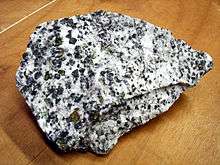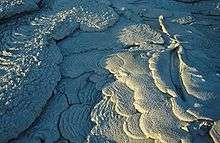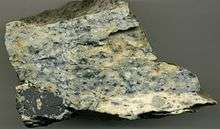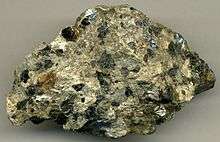Carbonatite
| Igneous rock | |
 | |
| Composition | |
|---|---|
| Primary | carbonate minerals, (> 50%) |
| Secondary | Other |

Carbonatite ( /kɑːrˈbɒnətaɪt/) is a type of intrusive or extrusive igneous rock defined by mineralogic composition consisting of greater than 50 percent carbonate minerals.[1] Carbonatites may be confused with marble, and may require geochemical verification.
Carbonatites usually occur as small plugs within zoned alkalic intrusive complexes, or as dikes, sills, breccias, and veins. They are, almost exclusively, associated with continental rift-related tectonic settings. It seems that there has been a steady increase in the carbonatitic igneous activity through the Earth's history, from the Archean Eon to the present.
Nearly all carbonatite occurrences are intrusives or subvolcanic intrusives. This is because carbonatite lava flows, being composed largely of soluble carbonates, are easily weathered and are therefore unlikely to be preserved in the geologic record. Carbonatite eruptions as lava may therefore not be as uncommon as thought, but they have been poorly preserved throughout the Earth's history.[2]
Only one carbonatite volcano is known to have erupted in historical time, the active Ol Doinyo Lengai volcano in Tanzania. It erupts with the lowest temperature lava in the world, at 500-600 °C. The lava is natrocarbonatite dominated by nyerereite and gregoryite.
Genesis
Carbonatites are rare, peculiar igneous rocks formed by unusual processes and from unusual source rocks. Three models of their formation exist:
- direct generation by very low degree partial melts in the mantle and melt differentiation
- liquid immiscibility between a carbonate melt and a silicate melt
- peculiar, extreme crystal fractionation
Evidence for each process exists, but the key is that these are unusual phenomena. Historically, carbonatites were thought to form by melting of limestone or marble by intrusion of magma but geochemical and mineralogical data discount this. For example, the carbon isotopic composition of carbonatites is mantle-like and not like sedimentary limestone.[3]
Mineralogy
Primary mineralogy is highly variable, but may include natrolite, sodalite, apatite, magnetite, barite, fluorite, ancylite group minerals, and other rare minerals not found in more common igneous rocks. Recognition of carbonatites may be difficult, especially as their mineralogy and texture may not differ much from marble save for the presence of igneous minerals. They may also be sources of mica or vermiculite.
Carbonatites are classed as calcitic sovite (coarse textured) and alvikite (finer textured) varieties or facies. The two are also distinguished by minor and trace element composition.[4][5] The terms rauhaugite and beforsite refer to dolomite- and ankerite-rich occurrences, respectively. The alkali-carbonatites are termed lengaite. Examples with 50 - 70% carbonate minerals are termed silico-carbonatites.[5] Additionally carbonatites may be either enriched in magnetite and apatite or rare earth elements, fluorine and barium.[6]
Natrocarbonatite is made up largely of two minerals, nyerereite (named after Julius Nyerere, the first president of independent Tanzania) and gregoryite (named after John Walter Gregory, one of the first geologists to study the East African Rift and author of the book The Great Rift Valley). These minerals are both carbonates in which sodium and potassium are present in significant quantities. Both are anhydrous and when they come into contact with the moisture in the atmosphere, they begin to react extremely quickly. The black or dark brown lava and ash erupted begins to turn white within a few hours.
Geochemistry

Carbonatite is composed predominantly of carbonate minerals and extremely unusual in its major element composition as compared to silicate igneous rocks, obviously because it is composed primarily of Na2O and CaO plus CO2.
Most carbonatites tend to include some silicate mineral fraction; by definition an igneous rock containing >50% carbonate minerals is classified as a carbonatite. Silicate minerals associated with such compositions are pyroxene, olivine, and silica-undersaturated minerals such as nepheline and other feldspathoids.
Geochemically, carbonatites are dominated by incompatible elements (Ba, Cs, Rb) and depletions in compatible elements (Hf, Zr, Ti). This together with their silica-undersaturated composition supports inferences that carbonatites are formed by low degrees of partial melting.
A specific type of hydrothermal alteration termed fenitization is typically associated with carbonatite intrusions. This alteration assemblage produces a unique rock mineralogy termed a fenite after its type locality, the Fen Complex in Norway. The alteration consists of metasomatic halos consisting of sodium rich silicates arfvedsonite, barkevikite and glaucophane along with phosphates, hematite and other iron and titanium oxides.[6]
Occurrence

Associated igneous rocks typically include ijolite, melteigite, teschenite, lamprophyres, phonolite, foyaite, shonkinite, silica undersaturated foid-bearing pyroxenite (essexite), and nepheline syenite.
Carbonatites are typically associated with undersaturated (low silica) igneous rocks that are either alkali (Na2O and K2O), ferric iron (Fe2O3) and zirconium-rich agpaitic rocks or alkali-poor, FeO-CaO-MgO-rich and zirconium-poor miaskitic rocks.[6]
The Mount Weld carbonatite is unassociated with a belt or suite of alkaline igneous rocks, although calc-alkaline magmas are known in the region. The genesis of this Archaean carbonatite remains contentious as it is the sole example of an Archaean carbonatite in Australia.
Intrusive morphology
Carbonatite is known to form in association with concentrically zoned complexes of alkaline-igneous rocks, the typical example of this being Phalaborwa, South Africa.
Carbonatites take the form of sills, lopoliths and rare dikes are reported in the Guyana Shield.
The Mud Tank and Mount Weld carbonatites take the form of multi-stage cylindrical intrusive bodies with several distinct phases of carbonatite intrusion. Smaller carbonatite sills and dikes are present in other Proterozoic mobile belts in Australia, typically as dikes and discontinuous pods.
Known examples
Dozens of carbonatites are known including:
- the Oka and Saint-Honoré, Quebec;
- Gem Park and Iron Hill, Colorado;
- Magnet Cove igneous complex, Arkansas;[6]
- Mountain Pass, California;[6]
- the Palabora Complex near Phalaborwa, South Africa;[6]
- Jacupiranga, Brazil;
- Ayopaya, Bolivia;
- Kovdor and Vischnevogorsk, Russia,
- Amba Dongar and Newania from India;
- the Mud Tank and Mount Weld, Australia;
- the Fen Complex, Norway;
- part of the basal complex of Fuerteventura, Spain;
- the Avon Volcanic District, Missouri.[7]
In 2017, the discovery of a new carbonatite deposit was confirmed north-west of Prince George, British Columbia, in a region termed the 'Rocky Mountain Rare Metal Belt'.[8]
The volcano Ol Doinyo Lengai, in the East African Rift is the world's only active carbonatite volcano. Other older carbonatite volcanoes are located in the same region, including Mount Homa.
Economic importance
Carbonatites may contain economic or anomalous concentrations of rare earth elements, phosphorus, niobium - tantalum, uranium, thorium, copper, iron, titanium, vanadium, barium, fluorine, zirconium, and other rare or incompatible elements. Apatite, barite and vermiculite are among the industrially important minerals associated with some carbonatites.[6]
Vein deposits of thorium, fluorite, or rare earth elements may be associated with carbonatites, and may be hosted internal to or within the metasomatized aureole of a carbonatite.
As an example the Palabora complex of South Africa has produced significant copper (as chalcopyrite, bornite and chalcocite), apatite, vermiculte along with lesser magnetite, linnaeite (cobalt), baddeleyite (zirconium-hafnium), and by-product gold, silver, nickel and platinum.[6]
References
- ↑ Bell, Keith (editor) (1989) Carbonatites: Genesis and Evolution, London, Unwin Hyman
- ↑ Stoppa, Francesco; Jones, Adrian P.; Sharygin, Victor V. (2009). "Nyerereite from carbonatite rocks at Vulture volcano: implications for mantle metasomatism and petrogenesis of alkali carbonate melts". Central European Journal of Geosciences. 1: 131–151. doi:10.2478/v10085-009-0012-9.
- ↑ Shavers, Ethan J.; Ghulam, Abduwasit; Encarnacion, John; Bridges, David L.; Luetkemeyer, P. Benjamin (2016-04-01). "Carbonatite associated with ultramafic diatremes in the Avon Volcanic District, Missouri, USA: Field, petrographic, and geochemical constraints". Lithos. 248–251: 506–516. doi:10.1016/j.lithos.2016.02.005.
- ↑ http://sajg.geoscienceworld.org/cgi/content/abstract/102/2/109 M. J. Le Bas, Sovite and alvikite; two chemically distinct calciocarbonatites C1 and C2, South African Journal of Geology; June 1999; v. 102; no. 2; p. 109-121
- 1 2 Peter Kresten, Carbonatite nomenclature, International Journal of Earth Sciences, Volume 72, Number 1 / February, 1983 http://www.springerlink.com/content/v1743q8021758340/
- 1 2 3 4 5 6 7 8 Guilbert, John M. and Charles F. Park, Jr., 1986, The Geology of Ore Deposits, Freeman, pp. 188 and 352-361 ISBN 0-7167-1456-6
- ↑ "Carbonatite associated with ultramafic diatremes in the Avon Volcanic District, Missouri, USA: Field, petrographic, and geochemical constraints".
- ↑ "German Geologist Discovers a Rare Carbonatite Complex in British Columbia" (PDF).
Sources
- Duncan R K, Willett G C (1990) - Mount Weld Carbonatite: in Hughes F E (Ed.), 1990 Geology of the Mineral Deposits of Australia & Papua New Guinea The AusIMM, Melbourne Mono 14, v1 pp 591–597
- "Carbonatite Deposits" (PDF). USGS Carbonatite Deposits. Retrieved January 31, 2005.
- "Descriptive Model of Carbonatite Deposits". USGS Descriptive Model of Carbonatite Deposits. Retrieved January 31, 2005.
- "World's Coolest Lava is in Africa". Volcano Watch April 17, 2003. Retrieved January 31, 2005.
- "Rare earth minerals in carbonatites of Basal Complex of Fuerteventura (Canary Islands, Spain)" (PDF).
- Bolivian carbonatite occurrences
External links
| Wikimedia Commons has media related to Carbonatite. |
- Photos of natrocarbonatite lava
- Ol Doinyo Lengai, Tanzania
- Ol Doinyo Lengai - The Mountain of God
- List of alkaline rock occurrences in the Americas
- Phosphate deposits of Australia, Mount Weld Carbonatite
- Description of the Mount Weld Carbonatite
- Blue River Carbonatites, British Columbia, Canada
- Video of molten carbonatite lava flow eruptions at Ol Doinyo Lengai volcano